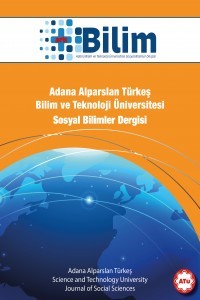Endüstriyel Ekolojiyi Anlamak Adına Endüstriyel Ortakyaşarlık Örneklerinin İncelenmesi
Yer kürenin taşıma kapasitesinin çok üstünde bir üretim ve tüketim döngüsüne girildiği, kaynakların sürdürülemez şekilde kullanıldığı görülmektedir. Mevcut durumun uzun vadede devam ettirilmesi mümkün olmayıp üretim ve tüketim süreçlerine ilişkin yapısal dönüşümlerin hızla hayata geçirilmesi kaçınılmazdır. Doğrusal ekonomi olarak adlandırılan mevcut üretim ve tüketim sisteminde atıklar tam olarak kullanılmamış hammaddeler içermektedir ve bunlar birçok endüstri için döngüsel materyal olma potansiyeli taşımaktadır. Tasarım ve teknolojideki gelişmeler ile hammadde, mamul veya yarı mamulün yaşamı boyunca daha fazla katma değer taşıması sağlanabilir ki bu da materyal ve enerji gereksinimi azaltabilir. Döngüsel ekonomi mantığı içinde gelişen endüstriyel ortakyaşarlık, belirli bir coğrafi alanda yer alan işletmeler arasındaki materyal ve enerji akışları yoluyla; kaynak girişi, atık, emisyon ve enerji kayıplarının minimize edildiği yenileyici bir sistemdir. Bu çalışmada bu ortakyaşarlık ilişkisine değinilmiş ve güncel örneklere yer verilmiştir.
Anahtar Kelimeler:
Endüstriyel Ekoloji, Döngüsel Ekonomi, Simbiyoz, Sürdürülebilirlik
Understanding Industrial Ecology by Inverstigating Industrial Symbiosis Examples
It is clearly realized that a production and consumption cycle is well over the earth carrying capacity and resources are used in an unsustainable manner. It is not possible to maintain the current situation in the long term and it is inevitable that the structural transformations of production and consumption routines will be implemented rapidly. In the current system of production and consumption, called the linear economy, wastes contain raw materials that are not fully used, and they have the potential to be cyclical material for many industries. With advances in design and technology, raw materials, finished products or semi-products can have more added value throughout their lives, which can reduce material and energy requirements. The concept of industrial symbiosis, which developed in the logic of circular economy, is a renewal system that minimizes loss of resources, waste, emissions and energy losses by covering material and energy flows between enterprises in a given geographical area. In this study, the relationship between this symbiosis relationship and the current examples are mentioned.
Keywords:
Industrial Ecology, Circular Economy, Symbiosis, Sustainability,
___
- Benyus, J. M. (2002). Biomimicry: innovation inspired by nature (William Morrow & Co. New York, NY).
- Chertow, M. R., & Lombardi, D. R. (2005). Quantifying economic and environmental benefits of co-located firms.
- Dünyanın Durumu. (2008). Sürdürülebilir bir ekonomi için yenilikler, Worldwatch Enstitüsü Raporu. TEMA Vakfı Yayınları, İstanbul.
- Dünyanın Durumu (2004). Sürdürülebilir toplum için Worldwatch Enstitüsü raporu, Türkiye İş Bankası Kültür Yayınları, TEMA Vakfı Yayınları, İstanbul.
- EEA (2015). The European environment — State and outlook 2015: Synthesis report, State of the Environment report.
- Geyer, R., & Jackson, T. (2004). Supply loops and their constraints: the industrial ecology of recycling and reuse. California Management Review, 46(2), 55-73.
- Graedel, T. E., & Allenby, B. R. (1995). Industrial Ecology Prentice Hall. Englewood Cliffs, NJ.
- Jacobsen, N. B. (2006). Industrial symbiosis in Kalundborg, Denmark: a quantitative assessment of economic and environmental aspects. Journal of industrial ecology, 10(1‐2), 239-255.
- Kemp, R., & Pearson, P. (2007). Final report MEI project about measuring eco-innovation. UM Merit, Maastricht, 10.
- Kennedy, S. (2007). Biomimicry/biomimetics: general principles and practical examples. The Science Creative Quarterly, (2).
- Krajnc, D. & Glavic, P. (2003). Indicators of sustainable production. Clean Technology Environment Policy, 5, 279–288.
- Lovins, A. B., Lovins, L. H., & Hawken, P. (1999). A road map for natural capitalism.
- Lyle, J. T. (1996). Regenerative design for sustainable development. John Wiley & Sons.
- Lowell Center For Sustainable Production. (1998). Sustainable production: a working definition. Informal Meeting of the Committee Members.
- O’Brien, C. (1999). Sustainable production-a new paradigm for a new millennium. International Journal of Production Economics, 60-61:1-7.
- Reap, J., Baumeister, D., & Bras, B. (2005). Holism, biomimicry and sustainable engineering. In ASME 2005 International Mechanical Engineering Congress and Exposition. American Society of Mechanical Engineers.
- Renner, G. T. (1947). Geography of industrial localization. Economic Geography, 23(3), 167-189.
- Van Beers, D., Bossilkov, A., Corder, G., & Van Berkel, R. (2007). Industrial symbiosis in the Australian minerals industry: the cases of Kwinana and Gladstone. Journal of Industrial Ecology, 11(1), 55-72.
- Başlangıç: 2018
- Yayıncı: Adana Alparslan Türkeş Bilim ve Teknoloji Üniversitesi
Sayıdaki Diğer Makaleler
Mücahit ERSOY, Fatma Nur TUĞAL
Endüstriyel Ekolojiyi Anlamak Adına Endüstriyel Ortakyaşarlık Örneklerinin İncelenmesi
Zorunlu Rotasyonun Bağımsız Denetim Kalitesi Üzerine Etkisi: Literatür Değerlendirmesi
Eleştirel Düşünme Bağlamında Dr. Parkyeri ve Kömür Karası Çocuk Adlı Çocuk Kitaplarının İncelenmesi
